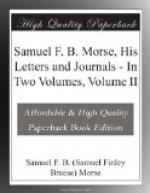The company was not startled by this remark; they soon turned to other subjects and thought no more of it. Little did they realize that this exclamation of Morse’s was to mark an epoch in civilization; that it was the germ of one of the greatest inventions of any age, an invention which not only revolutionized the methods by which intelligence was conveyed from place to place, but paved the way for the subjugation, to the uses of man in many other ways, of that mysterious fluid, electricity, which up to this time had remained but a plaything of the laboratory. In short, it ushered in the Age of Electricity. Least of all, perhaps, did that Dr. Jackson, who afterwards claimed to have given Morse all his ideas, apprehend the tremendous importance of that chance remark. The fixed idea had, however, taken root in Morse’s brain and obsessed him. He withdrew from the cabin and paced the deck, revolving in his mind the various means by which the object sought could be attained. Soon his ideas were so far focused that he sought to give them expression on paper, and he drew from his pocket one of the little sketch-books which he always carried with him, and rapidly jotted down in sketches and words the ideas as they rushed from his brain. This original sketch-book was burned in a mysterious fire which, some years later, during one of the many telegraph suits, destroyed many valuable papers. Fortunately, however, a certified copy had wisely been made, and this certified copy is now in the National Museum in Washington, and the reproduction here given of some of its pages will show that Morse’s first conception of a Recording Electric Magnetic Telegraph is practically the telegraph in universal use to-day.
[Illustration: Drawings from 1832 sketch book, showing first conception of telegraph]
His first thought was evidently of some system of signs which could be used to transmit intelligence, and he at once realized that nothing could be simpler than a point or a dot, a line or dash, and a space, and a combination of the three. Thus the first sketch shows the embryo of the dot-and-dash alphabet, applied only to numbers at first, but afterwards elaborated by Morse to represent all the letters of the alphabet.
Next he suggests a method by which these signs may be recorded permanently, evidently by chemical decomposition on a strip of paper passed along over two rollers. He then shows a message which could be sent by this means, interspersed with ideas for insulating the wires in tubes or pipes. And here I want to call attention to a point which has never, to my knowledge, been noticed before. In the message, which, in pursuance of his first idea, adhered to by him for several years, was to be sent by means of numbers, every word is numbered conventionally except the proper name “Cuvier,” and for this he put a number for each letter. How this was to be indicated was not made clear, but




